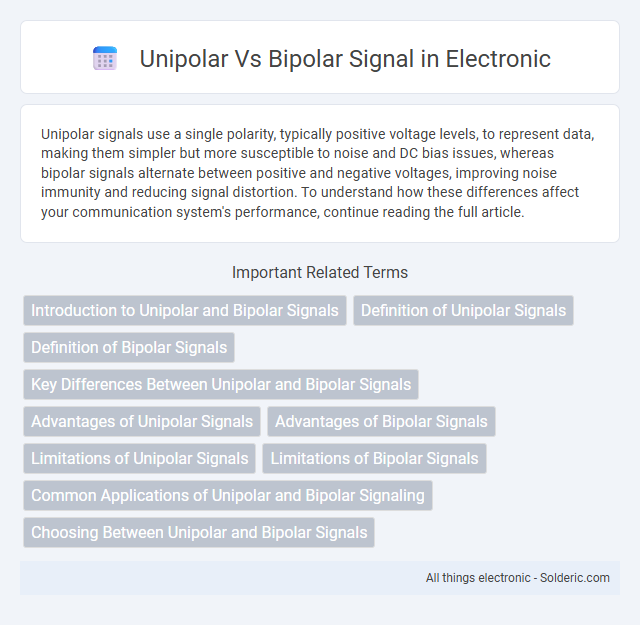Unipolar signals use a single polarity, typically positive voltage levels, to represent data, making them simpler but more susceptible to noise and DC bias issues, whereas bipolar signals alternate between positive and negative voltages, improving noise immunity and reducing signal distortion. To understand how these differences affect your communication system's performance, continue reading the full article.
Comparison Table
| Feature | Unipolar Signal | Bipolar Signal |
|---|---|---|
| Signal Levels | Positive voltage and zero | Positive and negative voltages |
| Voltage Range | 0 V to +V | -V to +V |
| Baseline Voltage | Zero volts | Zero centered |
| Power Efficiency | Lower, as signal stays positive | Higher, uses both polarities |
| Noise Immunity | Lower, prone to DC offset errors | Higher, better error detection |
| Complexity | Simpler transmitter and receiver | More complex implementation |
| Application | Simple digital circuits, low-speed communication | High-speed communication, data transmission |
Introduction to Unipolar and Bipolar Signals
Unipolar signals operate with a single polarity, typically ranging from 0 to a positive voltage, making them simpler for digital logic circuits but less efficient in noise resistance. Bipolar signals alternate between positive and negative voltage levels, enhancing noise immunity and reducing DC bias, which is advantageous in communication systems. Understanding these fundamental differences is crucial for selecting the appropriate signaling method in electronic data transmission.
Definition of Unipolar Signals
Unipolar signals are electrical signals that vary in amplitude using only one polarity, typically ranging from zero voltage to a positive voltage level. These signals are commonly used in digital communication systems where the signal is either present at a positive voltage (representing a binary 1) or absent at zero voltage (representing a binary 0). Your choice of unipolar signaling can simplify circuit design but may be more prone to baseline drift compared to bipolar signals.
Definition of Bipolar Signals
Bipolar signals are electrical signals that use two voltage levels, one positive and one negative, relative to a zero or ground reference point, allowing the signal to alternate between these polarities. This dual-polarity approach enhances noise immunity and reduces DC component buildup, making it ideal for long-distance communication and minimizing baseline wander in data transmission. Common bipolar signal formats include Alternate Mark Inversion (AMI) and Polar Non-Return to Zero (PNRZ), frequently employed in digital telecommunication systems.
Key Differences Between Unipolar and Bipolar Signals
Unipolar signals operate with a single voltage polarity, typically ranging from zero to a positive value, while bipolar signals alternate between positive and negative voltages around a zero reference. The unipolar signal's simplicity makes it ideal for digital logic circuits, whereas bipolar signals provide better noise immunity and signal integrity, especially in analog and communication systems. Your system's choice between unipolar and bipolar signals impacts power consumption, noise performance, and compatibility with various electronic components.
Advantages of Unipolar Signals
Unipolar signals offer simpler circuit design and lower power consumption compared to bipolar signals due to their single voltage level operation. They also minimize the complexity in transmitter and receiver synchronization since only a positive or zero voltage is utilized. This simplicity enhances reliability in digital communication systems, especially in cost-sensitive applications.
Advantages of Bipolar Signals
Bipolar signals offer significant advantages such as reduced electromagnetic interference and enhanced noise immunity, making them ideal for long-distance data transmission. Their ability to transmit both positive and negative voltage levels helps minimize signal distortion and improves overall system reliability. By using bipolar signaling, your communication systems achieve better performance in noisy environments compared to unipolar signals.
Limitations of Unipolar Signals
Unipolar signals are limited by their susceptibility to noise and interference due to having a single reference voltage, which reduces signal integrity and reliability in data transmission. These signals also face difficulties in distinguishing between a zero voltage level and a lack of signal, leading to potential errors in decoding information. Additionally, unipolar signaling has lower power efficiency compared to bipolar signals, as it constantly requires energy to maintain a positive voltage state.
Limitations of Bipolar Signals
Bipolar signals, while effective in reducing DC offset and improving signal integrity, face limitations such as increased complexity in transmitter and receiver design due to the requirement of two voltage levels. This complexity can lead to higher power consumption and potential synchronization issues in high-speed communication systems. Your choice of signaling must consider these factors to balance performance and system requirements effectively.
Common Applications of Unipolar and Bipolar Signaling
Unipolar signaling is common in digital electronics and microcontroller interfacing where simplicity and low power consumption are essential, such as in TTL logic circuits and LED displays. Bipolar signaling finds frequent use in telecommunications and audio systems, providing better noise immunity and signal integrity in Ethernet and analog audio transmissions. Understanding the differences helps you choose the appropriate signaling method for your specific application needs.
Choosing Between Unipolar and Bipolar Signals
Choosing between unipolar and bipolar signals depends on the application's noise immunity and power efficiency requirements. Unipolar signals use a single voltage level referenced to zero, offering simpler circuitry and lower power consumption, ideal for short-distance or low-cost communication. Bipolar signals alternate between positive and negative voltages, enhancing noise resistance and signal integrity, making them suitable for long-distance transmission and high-speed data communication.
Unipolar vs bipolar signal Infographic

 solderic.com
solderic.com